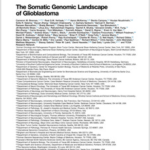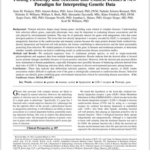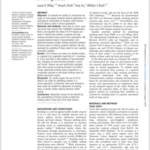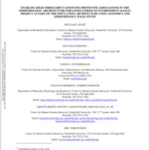G-protein coupled inwardly rectifying potassium (GIRK) channels are effectors determining degree of analgesia experienced upon opioid receptor activation by endogenous and exogenous opioids. The impact of GIRK-related genetic variation on human pain responses has received little research attention. We used a tag single nucleotide polymorphism (SNP) approach to comprehensively examine pain-related effects of KCNJ3 (GIRK1) […]
Tag Archives: Humans
The somatic genomic landscape of glioblastoma.
Brennan CW, Verhaak RG, McKenna A, Campos B, Noushmehr H, Salama SR, Zheng S, Chakravarty D, Sanborn JZ, Berman SH, Beroukhim R, Bernard B, Wu CJ, Genovese G, Shmulevich I, Barnholtz-Sloan J, Zou L, Vegesna R, Shukla SA, Ciriello G, Yung WK, Zhang W, Sougnez C, Mikkelsen T, Aldape K, Bigner DD, Van Meir EG, […]
The somatic genomic landscape of glioblastoma.
We describe the landscape of somatic genomic alterations based on multidimensional and comprehensive characterization of more than 500 glioblastoma tumors (GBMs). We identify several novel mutated genes as well as complex rearrangements of signature receptors, including EGFR and PDGFRA. TERT promoter mutations are shown to correlate with elevated mRNA expression, supporting a role in telomerase […]
Putting pleiotropy and selection into context defines a new paradigm for interpreting genetic data.
Natural selection shapes many human genes, including some related to complex diseases. Understanding how selection affects genes, especially pleiotropic ones, may be important in evaluating disease associations and the role played by environmental variation. This may be of particular interest for genes with antagonistic roles that cause divergent patterns of selection. The lectin-like low-density lipoprotein […]
Putting pleiotropy and selection into context defines a new paradigm for interpreting genetic data.
Predazzi IM, Rokas A, Deinard A, Schnetz-Boutaud N, Williams ND, Bush WS, Tacconelli A, Friedrich K, Fazio S, Novelli G, Haines JL, Sirugo G, Williams SM,. Natural selection shapes many human genes, including some related to complex diseases. Understanding how selection affects genes, especially pleiotropic ones, may be important in evaluating disease associations and the […]
ICD-9 tobacco use codes are effective identifiers of smoking status.
To evaluate the validity of, characterize the usage of, and propose potential research applications for International Classification of Diseases, Ninth Revision (ICD-9) tobacco codes in clinical populations.Using data on cancer cases and cancer-free controls from Vanderbilt’s biorepository, BioVU, we evaluated the utility of ICD-9 tobacco use codes to identify ever-smokers in general and high smoking […]
ICD-9 tobacco use codes are effective identifiers of smoking status.
Wiley LK, Shah A, Xu H, Bush WS,. To evaluate the validity of, characterize the usage of, and propose potential research applications for International Classification of Diseases, Ninth Revision (ICD-9) tobacco codes in clinical populations.Using data on cancer cases and cancer-free controls from Vanderbilt’s biorepository, BioVU, we evaluated the utility of ICD-9 tobacco use codes […]
Enabling high-throughput genotype-phenotype associations in the Epidemiologic Architecture for Genes Linked to Environment (EAGLE) project as part of the Population Architecture using Genomics and Epidemiology (PAGE) study.
Bush WS, Boston J, Pendergrass SA, Dumitrescu L, Goodloe R, Brown-Gentry K, Wilson S, McClellan B, Torstenson E, Basford MA, Spencer KL, Ritchie MD, Crawford DC,. Genetic association studies have rapidly become a major tool for identifying the genetic basis of common human diseases. The advent of cost-effective genotyping coupled with large collections of samples […]
Characterization of the Metabochip in diverse populations from the International HapMap Project in the Epidemiologic Architecture for Genes Linked to Environment (EAGLE) project.
Genome-wide association studies (GWAS) have identified hundreds of genomic regions associated with common human disease and quantitative traits. A major research avenue for mature genotype-phenotype associations is the identification of the true risk or functional variant for downstream molecular studies or personalized medicine applications. As part of the Population Architecture using Genomics and Epidemiology (PAGE) […]
Characterization of the Metabochip in diverse populations from the International HapMap Project in the Epidemiologic Architecture for Genes Linked to Environment (EAGLE) project.
Crawford DC, Goodloe R, Brown-Gentry K, Wilson S, Roberson J, Gillani NB, Ritchie MD, Dilks HH, Bush WS,. Genome-wide association studies (GWAS) have identified hundreds of genomic regions associated with common human disease and quantitative traits. A major research avenue for mature genotype-phenotype associations is the identification of the true risk or functional variant for […]
Enabling high-throughput genotype-phenotype associations in the Epidemiologic Architecture for Genes Linked to Environment (EAGLE) project as part of the Population Architecture using Genomics and Epidemiology (PAGE) study.
Genetic association studies have rapidly become a major tool for identifying the genetic basis of common human diseases. The advent of cost-effective genotyping coupled with large collections of samples linked to clinical outcomes and quantitative traits now make it possible to systematically characterize genotype-phenotype relationships in diverse populations and extensive datasets. To capitalize on these […]
A small number of candidate gene SNPs reveal continental ancestry in African Americans.
Using genetic data from an obesity candidate gene study of self-reported African Americans and European Americans, we investigated the number of Ancestry Informative Markers (AIMs) and candidate gene SNPs necessary to infer continental ancestry. Proportions of African and European ancestry were assessed with STRUCTURE (K 2), using 276 AIMs. These reference values were compared to […]












